A basic and fundamental technique in NLP is rapport building. Many people fixate on the strategies used to gain rapport but forget that it is equally as important to have the ability to identify once you have achieved it!
In NLP, we say that there are 4 indicators of rapport – meaning there are 4 ways in which you can assume that your rapport building efforts were successful.
The first indicator of having gained rapport is that the person you are communicating with may experience a colour change. In terms of ‘colour change,’ I am referring to their skin tone. This doesn’t necessarily mean that they become pinker and more blushed – but it could do. It could also be the case that they had a blush to their complexion when you first began communicating (and were not yet in rapport) and became paler as the rapport was being built. We’re not necessarily applying a particular meaning to their colour. Blushing in isolation doesn’t indicate that you have rapport. But a shift or change in their skin tone/colour tells you something has internally changed for them and we could attribute that to the rapport building paying off.
Most of the time, the colour change you will notice is from pale to blushed. Often when we have good rapport, we feel an emotional sense of warmness towards the other person. That warmness may manifest itself physically by making their cheeks a bit more rosy.
The second indicator of having successfully gained rapport is that we may have the ability to ‘lead’ the person we are communicating with. Initially, when we are building rapport with someone, we do so by matching and mirroring with them using our words, our tone and our physiology. This means that you do as they do. If their words relate to a particular subject matter, you would aim to match the subject by staying on topic. If their speech is fast you would mirror this by also speaking at speed in your responses. If their physiology is slumped, you would mirror your physiology to slump your posture too. There are many other elements to match and mirror in words, tone and physiology – these are just some simple examples. The process of doing what they are doing (coping them, is a crude but fairly accurate way of putting it) is called pacing. The purpose of pacing is to that you can later lead. Leading means that you are able to talk at a rate and speed that you are comfortable with, in a physiology you want to be in, discussing a subject of your choice and the person you are communicating with, begins to copy you. Expect in this instance, they are not conscious of matching and mirroring you. They are unconsciously working to maintain that rapport. We go into these processes in much more detail during our NLP Practitioner training which is designed to help NLP coaches build their business via our NLP Franchise.
If I were building rapport with someone and I noticed that, as they were talking they were leaning on their hand, then, as I respond to them, I will also begin leaning on my hand. This creates a mirror image of their physical posture. We like people who are in some way like us, even if it’s simply an unconscious awareness that their physiology is the same as ours. It helps to create a sense of connection and causes us to have greater rapport which makes leading possible.
The third indicator of rapport is that they might say something which tells you that they feel comfortable with you.
In fact, they might simply say “I feel comfortable with you!” It could be that they say something more logical as their mind is trying to make sense of the reason why they feel so comfortable with you, even though they may have only just met you. They may say something to the effect of “Have I met you somewhere before? Do you know so-and-so?” They conscious mind is a little bit tripped out by the sense of quick connection and tries to justify this by attributing the comfort with familiarity.
The fourth indicator of having gained rapport (which is my favourite and the most reliable in my opinion) is you just feel it. You internally feel as if are well connected with that person. You feel comfortable and at ease and the time passes by quickly. The conversation flows without too much effort even if you disagree in some parts. You are able to converse respectfully and easily.
By Gemma Bailey


